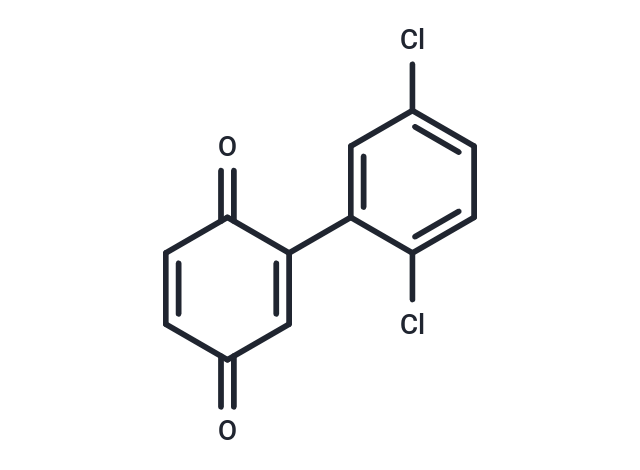Shopping Cart
Remove All Your shopping cart is currently empty
Your shopping cart is currently empty
TPI-1 is a SHP-1 inhibitor.

| Pack Size | Price | USA Warehouse | Global Warehouse | Quantity |
|---|---|---|---|---|
| 1 mg | $46 | In Stock | In Stock | |
| 2 mg | $67 | In Stock | In Stock | |
| 5 mg | $111 | In Stock | In Stock | |
| 10 mg | $188 | In Stock | In Stock | |
| 25 mg | $368 | In Stock | In Stock | |
| 50 mg | $559 | In Stock | In Stock | |
| 100 mg | $796 | In Stock | In Stock | |
| 1 mL x 10 mM (in DMSO) | $123 | In Stock | In Stock |
| Description | TPI-1 is a SHP-1 inhibitor. |
| Targets&IC50 | SHP1:40 nM. |
| In vitro | SHP-1 has been identified as a promising target for cancer therapy. TPI-1, starting at an effective concentration of 10 ng/mL, selectively enhances the phosphorylation of SHP-1 substrates (notably pLck-pY394) in Jurkat T cells, without significantly affecting pERK1/2 or pLck-pY505 levels. Moreover, TPI-1 promotes the induction of IFNγ+ cells both in mouse spleen and human peripheral blood[1], demonstrating its potential selectivity and therapeutic efficacy in a cellular context. |
| In vivo | TPI-1 effectively suppresses the growth of B16 melanoma tumors in mice through a mechanism reliant on T cells when administered orally at tolerable doses, yet it demonstrates minimal impact on B16 cell proliferation in vitro. Additionally, TPI-1 enhances the levels of pLck-pY394 and IFNγ+ cells in mice, further contributing to its anti-tumor activity. Notably, TPI-1 also restricts B16 tumor expansion and extends the survival of mice bearing tumors when given as a subcutaneously tolerated agent[1]. |
| Kinase Assay | Jump-In TI CHO-K cells stably expressing WT or mutant S1P3 are serum-starved for 4 hrs. They are then incubated at 4 °C for 30 min in the binding buffer containing 20 mM Tris-HCl (pH 7.5), 100 mM NaCl, 15 mM NaF, 0.5 mM EDTA, 1 mM Na3VO4, 0.5% fatty acid-free bovine serum albumin, and protease inhibitor mixture with 0.1 nM [33P]S1P and increasing concentrations of S1P, SPM-242, or CYM-5541. Cells are washed three times with cold binding buffer. Cell-bound radioactivity is measured by lysing the cells with 0.5% SDS followed by liquid scintillation counting. The raw data is normalized so that the level of [33P]S1P bound to each cell line (WT or mutant) in the absence of competing ligand is referenced as 100% for its own cell line[1]. |
| Synonyms | TPI1, TPI 1 |
| Molecular Weight | 253.08 |
| Formula | C12H6Cl2O2 |
| Cas No. | 79756-69-7 |
| Smiles | Clc1ccc(Cl)c(c1)C1=CC(=O)C=CC1=O |
| Relative Density. | no data available |
| Color | Yellow |
| Appearance | Solid |
| Storage | Powder: -20°C for 3 years | In solvent: -80°C for 1 year | Shipping with blue ice/Shipping at ambient temperature. | |||||||||||||||||||||||||||||||||||
| Solubility Information | DMSO: 45 mg/mL (177.81 mM), Sonication is recommended. | |||||||||||||||||||||||||||||||||||
| In Vivo Formulation | 10% DMSO+40% PEG300+5% Tween 80+45% Saline: 2 mg/mL (7.9 mM), Sonication is recommended. Please add the solvents sequentially, clarifying the solution as much as possible before adding the next one. Dissolve by heating and/or sonication if necessary. Working solution is recommended to be prepared and used immediately. The formulation provided above is for reference purposes only. In vivo formulations may vary and should be modified based on specific experimental conditions. | |||||||||||||||||||||||||||||||||||
Solution Preparation Table | ||||||||||||||||||||||||||||||||||||
DMSO
| ||||||||||||||||||||||||||||||||||||
| Size | Quantity | Unit Price | Amount | Operation |
|---|

Copyright © 2015-2025 TargetMol Chemicals Inc. All Rights Reserved.